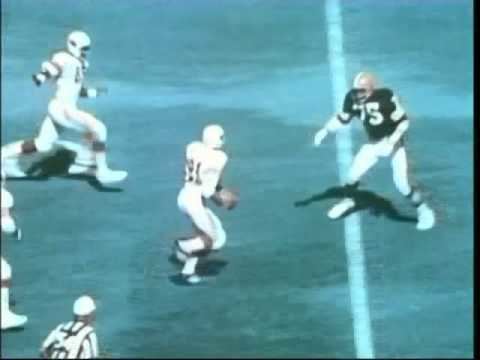The 1974 NFL season was the 55th regular season of the National Football League. The season ended with Super Bowl IX when the Pittsburgh Steelers defeated the Minnesota Vikings. Players held a strike from July 1 until August 10, prior to the regular season beginning; only one preseason game (that year's Chicago College All-Star Game) was canceled, and the preseason contests were held with all-rookie rosters.
The following changes were adopted to add tempo and action to the game (and to help counter the proposed changes announced by the World Football League to their games):
One sudden death overtime period (15 minutes) was added to all preseason and regular season games; if no team scored in this period, the game would result in a tie. This rule was enacted to decrease the number of tie games. The first ever regular season overtime, a September 22 game between the Pittsburgh Steelers and the Denver Broncos, ended in a 35–35 draw. It was not until November 10, when the New York Jets defeated the New York Giants, 26–20, that an overtime game would produce a winner. Since the 2012 season teams get one possession to score unless the team scores a touchdown or safety.Goal posts: moved from the goal line to the end line, where they were in 1932. This was to reduce the number of games being decided on field goals, and to increase their difficulty, as well as to reduce the risk of player injuries.Missed field goals: The defensive team takes possession of the ball at the line of scrimmage or the 20-yard line, whichever is farther from the goal line. (In 1994, that reference to the line of scrimmage was changed to the kick spot, which is usually 7 yards behind the line of scrimmage.) Notice that the 20-yard line is where the defense takes possession after a touchback.Kickoffs: moved to the 35-yard line (from the 40-yard line) to reduce touchbacks, promoting more excitement with kickoff returns. In 1994, the kickoff would be moved farther back, to the 30-yard line, where it remained before it returned to the original 1974 position since the 2011 season.Punt returns: members of the kicking team cannot go beyond the line of scrimmage until the ball is kicked, except the player at the farthest end of each side of the snapper. The original rule change would have prohibited any player from crossing the line of scrimmage prior to the ball being kicked.An eligible pass receiver can only be contacted once by defenders after the receiver has gone 3 yards beyond the line of scrimmage.When the defensive team commits an illegal use of hands, arms, or body foul from behind the line of scrimmage, the penalty will be assessed from the previous spot instead of the spot of the foul.The penalties for offensive holding, illegal use of hands, and tripping were reduced from 15-yards to 10-yards.Wide receivers blocking back towards the ball within three yards from the line of scrimmage may not block below the waist.Starting in 1970, and until 2002, there were three divisions (Eastern, Central and Western) in each conference. The winners of each division, and a fourth "wild card" team based on the best non-division winner, qualified for the playoffs. The tiebreaker rules were changed to start with head-to-head competition, followed by division records, common opponents records, and conference play.
Final standings
W = Wins, L = Losses, T = Ties, PCT= Winning Percentage, PF= Points For, PA = Points Against
x – clinched wild card berth, y – clinched division title
New England finished ahead of N.Y. Jets in the AFC East based on better record against common opponents (5–4 to Jets' 4–5).Houston finished ahead of Cincinnati in the AFC Central based on head-to-head sweep (2–0).Kansas City finished ahead of San Diego in the AFC West based on better record against common opponents (4–6 to Chargers' 3–7).St. Louis finished ahead of Washington in the NFC East based on head-to-head sweep (2–0).Note: Prior to the 1975 season, the home teams in the playoffs were decided based on a yearly rotation.
